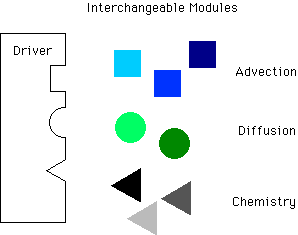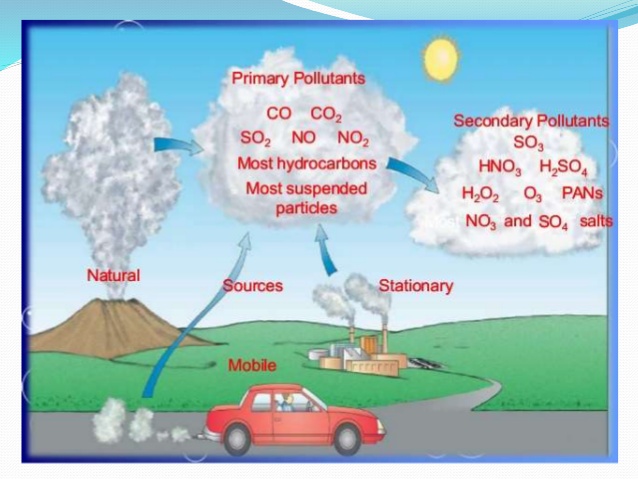Basic Information
Brief Introduction
The EPA Community Multiscale Air Quality (CMAQ) modeling system is a third-generation air quality model. The source code for CMAQ is available through a publically-accessible, version-controlled git repository on GitHub (www.github.com/usepa/cmaq) where interested parties may obtain the open-source software and contribute to enhancements of the model. CMAQ is designed for applications ranging from regulatory and policy analysis to understanding the complex interactions of atmospheric chemistry and physics. It is a three-dimensional Eulerian (i.e., gridded) atmospheric chemistry and transport modeling system that simulates ozone, particulate matter (PM), toxic airborne pollutants, visibility, and acidic and nutrient pollutant species throughout the troposphere. Designed as a “one-atmosphere” model, CMAQ can address the complex couplings among several air quality issues simultaneously across spatial scales ranging from local to hemispheric. The CMAQ source code is transparent and modular to facilitate the model’s extensibility through community development by all members of the air quality modeling community.

CMAQ Modeling Framework
Model Background
Air quality models integrate our understandings of the complex processes that affect the concentrations of pollutants in the atmosphere. Establishing the relationships among meteorology, chemical transformations, emissions of chemical species, and removal processes in the context of atmospheric pollutants is the fundamental goal of an air quality model (Seinfeld and Pandis, 1998). In contrast to statistical air quality models that use historical trends in observed atmospheric conditions to predict air pollution, CMAQ uses coupled mathematical representations of actual chemical and physical processes to simulate air quality. The model is based upon the underlying concept of preserving mass through a series of contiguous three-dimensional (3\‑D) grid cells covering a fixed model grid. A model grid is an x-y-z array that is fixed in space and covers a particular domain, i.e., a geographic area of interest. CMAQ therefore belongs to the Eulerian class of mathematical models that calculate a mass balance within each grid cell by solving the transport across each cell boundary and chemical transformations within each cell during a given time period. As a framework for simulating the interactions of multiple complex atmospheric processes, CMAQ thus requires two primary types of inputs: meteorological information, and emission rates from sources of emissions that affect air quality.
Model Goals
CMAQ is designed to meet the needs of the multiple groups contained within the air quality modeling community: research and regulatory modelers, algorithm and science module developers, air quality forecasters, and planners and policy makers. While each of these groups has distinct individual requirements for CMAQ, they also share a common need for an efficient, transparent, and scientifically credible tool to simulate air pollution formation and transport. To address these individual and common needs, CMAQ development and maintenance have the following goals:
- Scientific Integrity. Ensure that the model remains state-of-the-science through subjecting it to regular peer reviews
- Community Development. Utilize a design that encourages innovations and enhancements by all members of the air quality modeling community
- Multiscale Modeling. Provide adequate technical formulations to address air quality issues on multiple spatial scales, from urban to hemispheric
- One-Atmosphere Design. Provide robust and integrated science for modeling multiple, coupled air quality issues in a single simulation
- Modularity. Maintain flexibility to add new, or select from existing, science modules to optimize model performance for specific applications
- Transparency. Utilize programming practices that promote understanding of the model formulation at the source-code level
- Computational Efficiency. Provide scientifically acceptable results without compromising the speed at which the results are generated
- Open-Source Design. Enable no-cost distribution and application by the modeling community
Summary descriptions of the major CMAQ programs
Model Builder (Bldmake)
Bldmake provides an interface to CMAQ source code repository, and to the Fortran 90 compiler for building binary executables. Because Bldmake is required to create all of the CMAQ executables except MCIP (which has its own Makefile procedure), it is the first program that needs to be compiled after installing the CMAQ source code on your system. In addition to creating executables, it also provides the option to generate a Linux Makefile. These are particularly useful for porting the CMAQ code to new operating systems, testing new code in a development environment, or trouble-shooting problems with CMAQ compilation or execution.
Initial Conditions Processor (ICON)
ICON generates a gridded binary netCDF file of the chemical conditions in the modeling domain for the first hour of a simulation. It can generate these initial conditions from either an ASCII file of vertically resolved concentration profiles (distributed with CMAQ) or from an existing CCTM output file. If the profiles in an ASCII file do not have the same vertical structure as the CCTM configuration to be used, ICON will interpolate the data to a vertical structure consistent with CCTM’s. Using an existing CCTM output file to generate initial conditions is applicable when extrapolating initial conditions from a coarse to a fine grid simulation, as may occur when setting up nested simulations (simulations with finer-resolution grids that cover part of coarser-resolution grids).
Boundary Conditions Processor (BCON)
BCON generates a gridded binary netCDF file of the chemical conditions along the horizontal boundaries of the modeling domain. These boundary conditions can be either static or time-varying, and (as with ICON) can be generated from either an ASCII file of vertically resolved concentration profiles or from an existing CCTM output file. Also as with ICON, BCON will interpolate the data in ASCII profiles to a vertical resolution that is consistent with the CCTM configuration. BCON differs from ICON, however, in that it can generate time-varying (i.e., dynamic) boundary conditions. Dynamic boundary conditions are typically extracted either from CCTM outputs from a coarse-grid simulation for nested simulations or from a CCTM simulation using a global-scale model. The file structure of the ASCII input profiles can also support the creation of dynamic boundary conditions, but generally these files are used only for creating static data. The configuration options for BCON include selecting the chemical mechanism to model, defining the horizontal and vertical grids, and choosing whether the boundary conditions are generated from an ASCII profile or from an existing CCTM output file.
BCON is only used to create boundary conditions inputs for the CCTM from an ASCII profile file or from an existing CCTM output file. Users are responsible for preparing CCTM input boundary conditions from other sources, such as global chemistry transport models.
Meteorology-Chemistry Interface Processor (MCIP)
MCIP uses output files from the MM5 or WRF meteorological models to create netCDF-formatted input meteorology data that are used by SMOKE (the emissions processor that computes emissions inputs to CMAQ) and by CMAQ. MCIP prepares and diagnoses all meteorological fields that are required for SMOKE and CCTM. In addition, MCIP is currently used to calculate the time-varying, species-dependent dry deposition velocities that are used in CCTM. MCIP can be used to uniformly trim cells off the horizontal boundary of the domain defined by the meteorological model, or to window in on a subset of that domain. MCIP can also decrease the vertical resolution of the meteorological data by “layer collapsing,” although this option should be used with caution as it can degrade the quality of the data if used incorrectly. Configuration options for MCIP include the time periods over which to extract data from the meteorological model output files, horizontal and vertical grid definitions, and selections for calculating dry deposition velocities and integrating satellite cloud observations into MCIP output.
CMAQ Chemistry-Transport Model (CCTM)
CCTM integrates the output from the preprocessing programs described above (BCON, ICON, and MCIP), as well as CMAQ-ready emissions inputs (e.g., output from SMOKE), to simulate continuous atmospheric chemical conditions. The modeled concentrations of relevant species can be captured for output at a user-defined time frequency (typically hourly). The CCTM output files are all binary netCDF files of gridded and temporally resolved air pollutant information, such as gas- and aerosol-phase species mixing ratios, hourly wet and dry deposition values, visibility metrics, and integral-averaged concentrations.
The spatial and temporal coverages of CCTM are dictated by the input meteorology information. The science configuration is specific to each application of the model and can be adjusted to optimize model performance both computationally and in the numerical reproduction of observed air quality trends. Configuration options for CCTM include the temporal coverage of the simulation, the chemical mechanism to use in the modeling, the physics scheme to use for modeling pollutant transport, heterogeneous and aqueous chemistry options, inline processing options, and diagnostic options (such as process analysis, discussed in the next paragraph). CCTM has the largest number of configuration options of all the CMAQ programs.

CMAQ Chemistry-Transport Model (CCTM) and pre-processors
Chemical Mechanism Compiler (CHEMMECH)
This program creates chemical mechanism namelist files for CMAQ from a mechanism definition file. Chemical mechanisms are represented in CMAQ through a series of namelist files that contain mechanistic and kinetic parameters that describe a photochemical mechanism. CHEMMECH creates the namelist files from an ASCII mechanism-definition file that represents the chemistry as sequential equations of reactants, products, and reaction rate information. This program is needed to modify reaction stoichiometry or kinetics in the existing mechanisms, to add new species and reactions, and to implement entirely new chemical mechanisms in CMAQ.
EBI chemistry solver builder (CREATE_EBI)
The Euler Backward Iterative (EBI) chemistry solver is an optimized numerical solver for CCTM photochemical mechanisms. As the EBI solver is optimized for a specific chemistry mechanism configuration, a new version of the EBI solver is required for new CCTM photochemical mechanisms. The program CREATE_EBI is a CCTM source code generator for new mechanism versions. Mechanism input files for CREATE_EBI are produced by the CMAQ program CHEMMECH. The source code generated by CREATE_EBI may be used to compile a new version of the CCTM for use with updated chemistry namelist files created with CHEMMECH.
The inline photolysis preprocessor creates photolysis reaction parameter tables for the CCTM inline photlysis module.
The nml program converts chemical mechanism csv output files from chemmech to the namelist files required by the CMAQ programs.
JPROC calculates daily clear-sky photolysis rates from look-up tables of molecular absorption cross-section and quantum yield (CSQY) data, and climatologically derived ozone-column and optical depth data.











